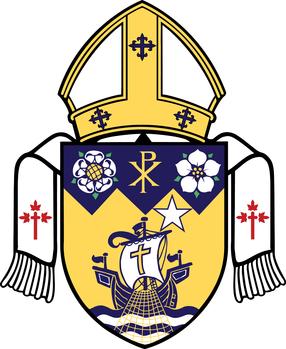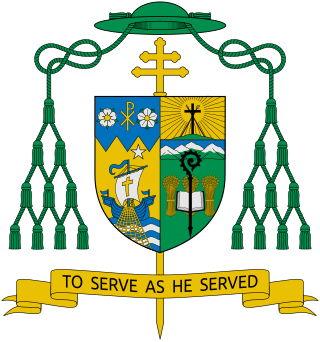
Edward Michael Egan was an American cardinal of the Catholic Church. He served as bishop of the Diocese of Bridgeport in Connecticut from 1988 to 2000 and as archbishop of the Archdiocese of New York in New York City from 2000 to 2009. He was elevated to the cardinalate in 2001.
The hierarchy of the Catholic Church consists of its bishops, priests, and deacons. In the ecclesiological sense of the term, "hierarchy" strictly means the "holy ordering" of the church, the Body of Christ, so to respect the diversity of gifts and ministries necessary for genuine unity.
William Edward Cousins was an American prelate of the Catholic Church. He served as an auxiliary bishop of the Archdiocese of Chicago in Illinois (1948–1952), as bishop of the Diocese of Peoria in Illinois (1952–1958) and as archbishop of the Archdiocese of Milwaukee in Wisconsin (1958–1977).

The Roman Catholic Archdiocese of Vancouver is a Roman Catholic Latin archdiocese that includes part of the Canadian province of British Columbia.

Joseph Nathaniel Perry is an American prelate of the Roman Catholic Church who served as an auxiliary bishop for the Archdiocese of Chicago from 1998 to 2023.

Adam Joseph Exner, OMI was a Canadian bishop of the Catholic Church. He was the Archbishop of Vancouver from 1991 until 2004, having previously served as the Bishop of Kamloops and Archbishop of Winnipeg. Prior to his appointment as bishop, he was a professor at seminaries run by his religious order.
Philip Francis Pocock was the Roman Catholic Archbishop of Toronto from 1971 to 1978.

The Roman Catholic Diocese of Kamloops is a suffragan of the Archdiocese of Vancouver. The Diocese of Kamloops is led by Bishop Joseph Phuong Nguyen.
James Francis Carney was a Canadian archbishop of the Roman Catholic Church. He served as the eighth Archbishop of Vancouver, British Columbia, from 1964 until his death in 1990. He was the first Archbishop of Vancouver born in the city of Vancouver.

Josu Iriondo is a Spanish-born American prelate of the Roman Catholic Church who served as an auxiliary bishop of the Archdiocese of New York from 2001 to 2014.
John Richard Keating was an American prelate of the Roman Catholic Church. He served as bishop of the Diocese of Arlington in Virginia from 1983 until his death.

Edward Joseph Weisenburger, J.C.L., is an American prelate of the Roman Catholic Church, serving as the bishop of the Diocese of Tucson in Arizona since 2017. He previously served as the bishop of the Diocese of Salina in Kansas from 2012 to 2017.
Raymond James Vonesh was an American Bishop of the Catholic Church. He served as an auxiliary bishop of the Diocese of Joliet in Illinois from 1968–1991.

Joseph Phuong Nguyen, also known as Joseph Nguyễn Thế Phương, is a Canadian prelate of the Roman Catholic Church. On June 1, 2016, Nguyen became the Bishop-elect of the Diocese of Kamloops. Prior to his appointment, Nguyen held the post of Vicar General for the Archdiocese of Vancouver, second to Archbishop Miller.

Stephen Arthur Jensen is a Canadian prelate of the Roman Catholic Church. He was ordained a priest on May 24, 1980, by then-Archbishop James Francis Carney. On April 2, 2013, he was ordained Bishop of the Diocese of Prince George.

Robert Gerald Casey is an American prelate of the Roman Catholic Church. He has been serving as an auxiliary bishop for the Archdiocese of Chicago in Illinois since 2018.
Francis Chan was a Singaporean bishop of the Catholic Church. After finishing high school in Singapore, he studied for the priesthood at College General in Penang and was ordained a priest in 1939. Chan first served as an assistant pastor in Ipoh until 1946, with a three year interruption due to World War II. He subsequently returned to his hometown after the Japanese occupation ended and served as parish priest there for nine years. When the Holy See created the first two Malaysian dioceses of Kuala Lumpur and Penang in 1955, Chan was appointed as bishop of the latter see. He was consecrated in August of that same year, becoming one of the first two local bishops from Malaysia. A Council Father of the Second Vatican Council, Chan attended two sessions held at St. Peter's Basilica in 1962 and 1964. He died of terminal cancer in 1967. Chan was dubbed "The Singing Bishop" due to his penchant for music.

Richard Joseph Gagnon is a Canadian bishop of the Catholic Church. He is the Archbishop of Winnipeg, appointed to the position in 2014 after previously serving as the Bishop of Victoria. He has also served as President of the Canadian Conference of Catholic Bishops (CCCB) since September 2019. Gagnon attended high school and university in Greater Vancouver, before studying for the priesthood at the Pontifical Beda College in Rome. He was ordained a priest in 1983 and served in the Archdiocese of Vancouver as an assistant pastor and parish priest for two decades. He became vicar general of the archdiocese in 2002 and was consecrated as a bishop two years later. Gagnon has been noted for his work toward reconciliation with Indigenous peoples in Victoria and Winnipeg. He is also noted for calling the first diocesan synod in the Archdiocese of Winnipeg.

Louis Tylka is an American prelate of the Roman Catholic Church who became bishop of the Diocese of Peoria in Illinois in 2022 after 19 months as coadjutor bishop there.














